I like to call craft-brewed beer a cerebral beverage. Based on all the flavors, variety and innovation going on today, it certainly gives beer lovers much to talk about — but therein lies the challenge.
In talking about flavor on a daily basis, I’ve searched high and low for a solid answer on what exactly flavor is, how the heck we perceive it, and more importantly, describe it.
Admittedly, as one on a flavor-finding journey, and ever a palate athlete in training — we train each bite, people — the bottom line is flavors are often difficult to describe. There are a multitude of books on the very topic. A new one that relates directly to pairing is Beer, Food, and Flavor by Schuyler Schultz.
Schultz talks about tasting in terms of attack: primary, secondary and tertiary flavor characteristics, finish, balance and dimension. There’s also the stand-by bible Tasting BeerOpens in new window by Randy Mosher. For those who really want to geek out, read NeurogastronomyOpens in new window by Gordon Shepherd, or Sensory Evaluation TechniquesOpens in new window by Morten Meilgaard, Gail Vance Civille and B. Thomas Carr.
Flavor = Taste + Aroma
In January, I attended a fantastic three-hour seminar presented by Ray Daniels and Nicole Erny of the Cicerone® Certification ProgramOpens in new window titled “Flavor & Tasting.” This is more of what the craft beer world needs to hear to help us understand and better describe flavors.
Daniels emphasized right out of the gates that flavor = taste + aroma. Sit with that one for a moment while I share it again. Flavor = taste + aroma. I often liken a new taster’s experience to being blind, with no reference to the primary colors. In this scenario, primary colors are taste elements like sweet, salt, sour, umami and bitter. On my beer journey, it took a while to mentally detect and separate these elements. Until a taster has reference to what they perceive, they have a hard time describing (internally or externally) what flavors they’re detecting.
For example, here is a recent inner dialog I had, yes with myself, while tasting a very fresh American IPA— a very hop-centric beer. “Oh wow, mid-taste I get mango … no wait, it’s more like passion fruit … nope, it’s way closer to pineapple. I taste lemon-citrus, but yet smell more tropical fruit.”
Sound familiar? Well, that inner conversation would have been way different if I had never tried pineapple, passion fruit or mango in the first place, as I would have been unable to reference those as flavors and aromatics. You with me? So part of the take away here is that tasting craft beer is more than just tasting, it’s the whole experience.
Similar to how a musician might want to understand how our ears help us hear, or a painter might want to fully understand how our eyes allow us to see, I’m a craft beer foodie who wants to know how our tongue, palate, nose and mind help us perceive flavors.
The Four Main Taste Sensations
So here goes! Flavor is a compilation (fusion) of different perceptions of our five senses. Yes, my dear friend, flavor is a fusion. Based on my journey thus far, here is how I summarize the four main sensations that collectively work in concert when we sample: smell, taste, sensation and experience.
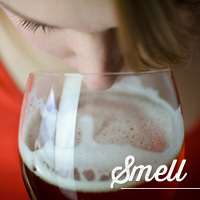 1. Smell
1. Smell
Smell is the dominant sense affecting flavor perception. Without it, what we taste would be very simplistic and much more one-dimensional. Thus smell is a synthetic experience, in that the brain has a hard time picking apart the individual pieces, compared to taste which is an analytic experience where our brain can dissect the parts more easily.
Smell is an aromatic experience that happens via two reactions:
- Orthonasal: Sniffing with the nose (nostrils), what is perceived and chemically interpreted by the brain.
- Retronasal: Chemical reactions that take place where the nose and mouth meet. When we taste food (or beer), it gives off aroma vapors. Humans have about 300 odor receptors that act in combination to allow us to detect 10,000 (or more) possible aromas.
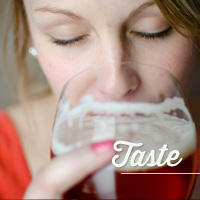 2. Taste
2. Taste
Taste is a chemical sense perceived by receptors on the tongue and soft palate. On the tongue, taste cells are housed in taste buds, which in turn are housed in the papillae that are the bumps on our tongue. We also have filiform papillae which do not have taste buds, but act to help grind down food in the mouth.
Each taste bud is composed of 40-100 taste cells. Each cell is specific to a singular taste modality, and you can have any combination of taste cells in one taste bud. There is a taste pore at the top the taste bud. Food molecules dissolved in saliva enter into the taste bud through the pore and interact with the taste cells receptors that are on extensions of the cell called microvilli for sweet, bitter and umami. It is thought that salt and sour molecules enter through a gated channel. Either of these pathways activates the cell and sends a chemical signal through the cell which is transformed into an electrical signal in our nerves to the brain. The brain then takes detection to the level of perception, and ultimately to make a decision to consume or spit out.
The main tastes we detect are:
- Sweet: brain thinks energy
- Salty: brain thinks ions
- Sour: brain things spoiled (sour milk) or good (orange juice) or toxic
- Bitter: brain thinks toxic (poisonous plants) but this innate reaction can be overcome (beer bitterness/coffee roast)
- Umami: brain thinks protein (savory richness: what an aged steak delivers that a fresh cut does not; think parmesan cheese or soy sauce)
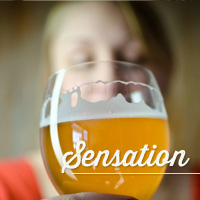 3. Touch/Somatosensory
3. Touch/Somatosensory
The sensations of temperature, pain and texture in the mouth are in fact a subset of the same receptors in your skin. These sensations are detected by free nerve endings in the mouth by the trigeminal nerve—now those are two very big words! Basically, it’s the physical and chemical sensory ability of the skin and mucus membranes to interpret sensations like mouthfeel, temperature, carbonation, body, cooling, burning or numbing, tearing and astringency. All of which, when combined with our other senses, help us create the entire flavor enchilada.
4. Experience
Small details you may not even be aware of in your surroundings can have a big impact on your tasting experience.
- Atmosphere: Is the room quiet or loud? Cold or hot? Are you extremely hungry? Are you distracted?
- Memories: Is there a good or bad experience being triggered by what you are seeing, hearing, feeling, smelling and tasting?
- Influence of others: If someone around you says, “Oh this tastes bitter,” that might influence your mental interpretation of what you are perceiving.
- What you’ve previously consumed: Flavors from what you’ve ingested earlier might carry over to what you are tasting now.
So with all that, and mind you I’ve skipped a lot of the scientific mumbo jumbo, go forth my fellow palate athletes. Taste, describe, repeat and build those reference memory muscles.
CraftBeer.com is fully dedicated to small and independent U.S. breweries. We are published by the Brewers Association, the not-for-profit trade group dedicated to promoting and protecting America’s small and independent craft brewers. Stories and opinions shared on CraftBeer.com do not imply endorsement by or positions taken by the Brewers Association or its members.
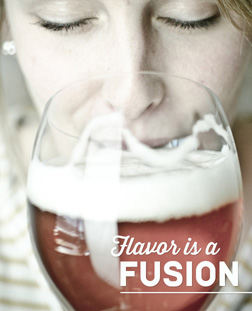

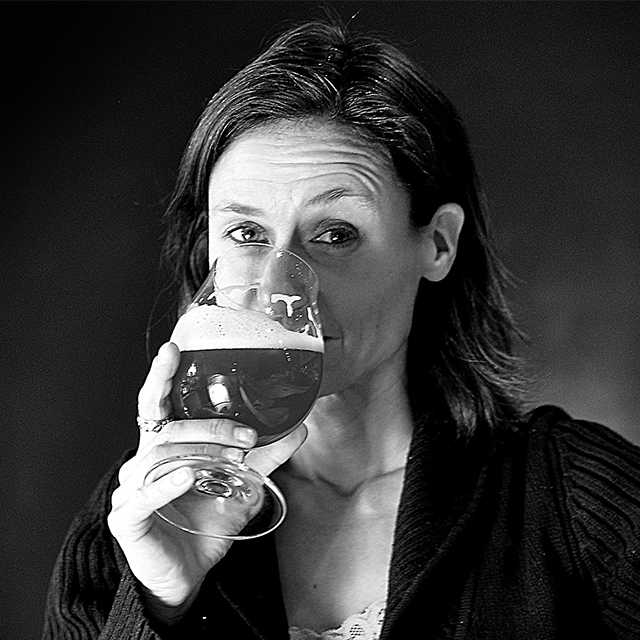
Share Post